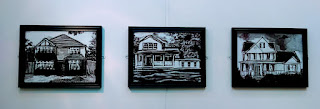It was a perfect title for an art show.
Leaky Roof, presented by students at Bradford School of Art,
was so named due to the water which flooded the studio whenever it rained
heavily. On the day of the preview in June,it had been sunny and there was little trace of
the streams of water which had threatened to turn the event into a damp squib,
apart from one or two strategically placed buckets beside the artworks.
Dealing with inclement weather was only one of the obstacles
which students of fine art had grappled with in the months leading up to the
show. The head technician who in previous years had been vital to the show's
preparation had quit two weeks previously; and there was a dearth of tutors - due
to sickness and retirement. Only one tutor had been available - albeit forced
to work extra hours - to oversee the setting up of the culmination of students'
three years of hard work.
Two days before the show was due to open, one student
approached the head of the
school to plead for something to be done. Water was leaking through the roof
and pooling around the digital prints which he had been preparing for display.
 |
| An artist prepares her work for display amid flood issues |
The gutters were blocked, he was told, and then the usual
mantra - there's no money for repairs.
Bradford College recently spent £50 million on creating its
new Hockney building and the new Advanced Technologies Centre with the view that the new campuses would
"continue the College’s ongoing commitment to positively contribute to the
regeneration of Bradford, its people and its industries." The new
buildings are shiny and new and when it rains, the roofs do not leak.
The art school, however, is based in the Lister Building
which dates back to the early 1900s. Despite undergoing a £2.8m refurbishment
to accommodate a café and exhibition area, the roof still leaks. The buckets
catching drips could be mistaken as artwork. Toilets are often closed as they
are inaccessible due to the puddles of water.
Despite too much water and too few tutors, this year's event was nonetheless a showcase of talent with work created by BA art students
displayed alongside fashion, graphics, textiles and 3D make-up and effects.
(However, the textile show had to be moved from its regular spot in the exhibition
gallery to the cafe to avoid the leaks.)
Art photographer and sculptor Charman Clark created
'Brompton -Behind Closed Doors', an eerie yet intriguing look at houses. Along
with her sublime digital images and laser cut edifices, Charman hid models of five handmade ceramic houses in various locations near her home.
Visitors were able to log on to her website for the co-ordinates and if found, were asked
to post a picture on her website.
https://gingerfinger.wixsite.com/brompton/behind-closed-doors
Ian Dashper stripped away layers to look at gender in
his breathtaking display which comprised of large digital screenprints and
full-sized porcelain casts of a 'female' and 'male' shoe. Ann Driver, who came to the end of her part-time course after six years in the art college, focused on empathy and her ceramic hanging 'rags' stir up emotions with their
bleak beauty.
Krzysztof Olejniczak created a 'ghost of forest'
painting as a homage to his father, who worked as a woodcutter for many years. He also made an eye-catching slice of miniature life with tiny model people
depicted on various floors in a building, looking at pictures in an art
gallery, lying face-down on a bed, and in the shower. Apryl Sharp's ethereal
collages offer hints of Victoriana while Pauline Cooke's lines and squiggles
were delicately presented on fabric.
 |
| Charman Clark |
 |
Ann Driver |
 |
| Krzysztof Olejniczak |
 |
| Ian Dashper |
 |
| Apryl Sharp |
 |
| Krzysztof Olejniczak |
 |
| Water, water, everywhere |






